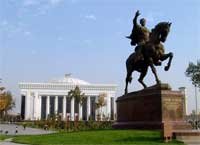August 11, 2014
New commission to protect cultural and archeological heritage objects. 2
Tourism: minarets of uzbekistan.. 2
Some 28 athletes to represent Uzbekistan at Youth Olympic Games. 6
economy
The Right Dimension
The manufacture of vehicles in Uzbekistan is one of the most dynamic segments of the real GDP. Automotive production increased by 6.3% in the first half of 2014.
The growth in the production of cars has been quite anticipated. A small sales decrease in Russia was easily compensated by the stable demands from the local market. However, a 24% increase in the manufacture of buses and an 18.9% increase in the production of heavy goods vehicles, which are influenced by many variable factors, has been a welcoming surprise.
Another surprise was the manufacture of smaller vehicles and family cars. Production models such as Captiva, Malibu and Cobalt have increased 2.8 times, 1.8 times and 9.7% respectively. Recently adopted production vehicles, such as, Gentra and Orlando reached 27 thousand and 563 thousand cars, respectively.
The manufacture of vehicle parts is also on the rise. The output of lithium batteries, used to start the piston engines, has increased by 10.3%, whereas the output of radiators, exhausts, exhaust pipes, clutch parts and hydraulics has gone up by 27.1%. Engines, tires and other similar parts have jumped up 2.9 times.
(Source: «Uzbekistan Today» newspaper)
CULTURE
New commission to protect cultural and archeological heritage objects
The Governmental commission on coordination of issues of protection and use of objects of cultural and archeological heritage was created in Uzbekistan.
The commission was set up with the resolution of the Cabinet of Ministers from 21 July 2014. The document was adopted for further improving system of protection and use of objects of cultural and archeological heritage was created in Uzbekistan.
The main task of the commission are to coordinate activities and cooperation of the state bodies and businesses entities on issues related to protection and use of cultural and archeological heritage, prepare proposals on implementation of main directions of the state policy on protection of cultural and archeological heritage, consider issues related to protection of cultural and archeological heritage, etc.
The resolution also approved a regulation of the main scientific-production department on protection of cultural and archeological heritage under the Ministry of Culture and Sport Affairs and its regional inspections.
The department will carry out state control over adhereance of legal entities and individuals on implementation of the legislation on protection of cultural and archeological heritage, participate in development of the state programmes, control use of objects, etc.
The department will be financed due to own income and budget resources.
(Source: UzDaily.com)
Tourism: minarets of uzbekistan
Towers of light
For many centuries, minarets are the distinctive architectural features of Moslem East. A minaret, designed to call Moslems to prayer, was an essential part of any cathedral mosque.
The word “minaret” or “minara” derives from Arabic “lighthouse”. The philosophical sense of the word “minaret” or “tower of light” implies the spiritual light, a symbol of human soul aspiring to divine enlightenment.
As is known, the architectural form of minarets is rooted in the pre-Islamic history. Their prototypes might have been mileposts with fire or idols atop them; they marked the distance and served as beacons for nomadic tribes. They might have been Buddhist memorial pillars stambhas, as well as the shapes of citadel walls known from the Bronze Age.
The shape was dictated both by practical reasons (providing a vantage focal point and using acoustic properties) and ideological considerations (an attribute of power, a triumphal monument).
A Buddhist stupa unearthed in the ruins of Old Termez is one of the first known structures of the kind ever discovered in the territory of Uzbekistan. This is the Tower Zurmala (2nd century AD).
Minarets of Uzbekistan are round brick towers tapering to the top. There is a spiral staircase inside the tower shaft. The minaret top is crowned with an arched rotunda. The construction of minarets required outstanding craftsmanship, since the builders had to take into account many factors, such as wind strength, seismic events and soil compactness.
If we assume that the age of some minarets is practically incredible by modern standards, there is nothing else left to do but to kneel before the greatness of the builders’ genius.
Jarkurgan Minaret, built in 1108-1110, is unique. This is one of the earliest known towers in the territory of Uzbekistan. The minaret presents a striking departure from architectural traditions of Central Asia. Its singularity consists in its “ribbed” walls, which very much resemble the tower mausoleums of Khorasan and India, Such tradition of decorating the walls with “goffers” is known from early medieval (7th-8th centuries) feudal castles in Central Asia – from Varakhsha palace, in particular.
Only the lower section of the minaret has survived until now. Its height is 12,6 meters, and its base is 5,4 meters in diameter. Closer to the minaret top, the fishbone design of the vertical wall ribs is added by a horizontal string of epigraphy. Ornamental brickwork and artistic elegance of the minaret strike our imagination.
The tallest of survived minarets – Kalyan (Minorai Kalon) (Great) Minaret in Bukhara – was made in the form of a conical baked brick tower of 47 meters in height. The minaret base goes back 10 meters. The tower has 12 ornamental belts, each of them being decorated in its own way. The body of the minaret is topped by a rotunda with 16 arched fenestrations and cornices adorned with stalactites.
 S.M. Prokudin-Gorsky. Big Minaret in old Bukhara.(Minaret Kalyan)
S.M. Prokudin-Gorsky. Big Minaret in old Bukhara.(Minaret Kalyan)
Besides answering its designated purpose, the minaret served as an illuminated watch house for caravans lost in the sand sea of the desert.
The local legend says that having destroyed half the city, great Genghis Han entered into the square near the tower and raised his head to look at the minaret. Quite of a sudden, his helmet fell off his head, and the warlord had to bend to pick it up. “I never bowed to anyone”, said the distinguished warrior. “But this edifice is so grandiose that it deserves a bow”.
It should be mentioned that all the later minarets, constructed in the Bukhara oasis, represented either a smaller copy or imitation of Kalyan. However, even Gaukushon and Vangozi, the tallest tower-like structures in Bukhara of the 16th century, were 2-2,5 times as small as their prototype. The most distinctive feature of the Bukhara minarets was an unusual form of their rotundas, which slightly overhung the minaret body.
Islam-Khoja Minaret in Khiva (1908-1910) stands out sharply against the structures of a later date. By the way, it is reckoned among 50 minarets of the city. It is 57 meters high (including the foundation), its diameter at the bottom is 9,5 meters. The form of the tower goes back to ancient minarets of the 11th and 12th centuries. The minaret body is sharply conical; its top is crowned by a cornice and small dome. The minaret has sky-blue, dark blue, white and turquoise green ornamental strings belted across it. By its beauty and elegance, Islam-Khoja can be compared only with Kalyan minaret in Bukhara.
 View over Khiva from Islam Khoja Minaret
View over Khiva from Islam Khoja Minaret
Another minaret in Khiva, Kalta Minor, should have become the tallest and biggest one in the world. Though unfinished, it strikes by boldness of the author’s message and its dimensions. The minaret base goes back 15 meters, its diameter at the bottom is 14,5 meters and its height reaches 29 meters. But this is only one-third of its original height. The court architect failed to implement his project, because Muhammad Amin Khan, ambitious ruler of Khiva, was killed in 1855. His death was a recompense for exorbitant taxes he was collecting in order to build the minaret. As a result, the minaret remained unfinished and received its name Kalta (Short).
Apart from free standing minarets, the attached ones are also worthy of mention. For example, the minarets of the Reghistan ensemble in Samarkand. Originally, there were ten towers, and only six of them preserve their classical look now. It should be mentioned that the minarets of Ulugbek and Sherdor Madrasahs were once 10-12 meters taller.
Tall and well-proportioned minarets used to rise in four corners of Gur-Emir Mausoleum courtyard. Two towers on the northern part were destroyed by the earthquake in the 19th century. Those on the southern side were restored by Samarkand restorers in 1996, but they became half as tail.
Corner towers resembling minarets were a decorative element of fortified rabats – the first militarized settlements of Arabs. They were destined to become the forerunners of caravanserais, i.e. accommodations houses. The guldasta turrets adorned portals at the entrance to citadels, fortified residences, palaces and country houses of the then rulers. They were also used in traditional architecture. Ark of Bukhara is one of the most striking examples of the trend, in this case, minarets worked as defensive facilities and watchtowers.
Starting as of the 14th – 15th centuries, there appeared more minarets in Central Asia then the ritual functions required. They were erected either as a symbol of the state or personal prestige, or as nonfunctional, though aesthetically essential elements of architectural design.
(Source: «Uzbekistan airways» magazine)
sport
Some 28 athletes to represent Uzbekistan at Youth Olympic Games
About 28 athletes from Uzbekistan will participate in the Second Summer Youth Olympic Games, the press service e of National Olympic Committee of Uzbekistan said.
The Second Summer Youth Olympic Games will be held in Nanjing, China, from 16 to 28 August 2014.
Uzbek athletes will compete in 14 sports, including rhythmic gymnastics, artistic gymnastics, weightlifting, boxing, trampoline, rowing, shooting sports, wrestling, judo, taekwondo, rowing and canoeing, table tennis and swimming.
Defending amateur champion on boxing among juniors Bektemir Melikuziev will be flagbearer of Uzbekistan national team at the solemn opening ceremony of the Second Summer Youth Olympic Games. Uzbekistan team will head to Nanjing on 11 August.
The meeting was held at Olympic Glory Museum in Tashkent. President of NOC Uzbekistan Mirabrar Usmanov wished good luck to athletes and hand over prizes of NOC Uzbekistan to them.
It is expected that the Second Summer Youth Olympic Games will be attended by 3,500 athl
(Source: UzDaily.com)






















